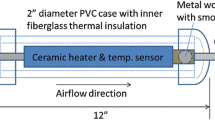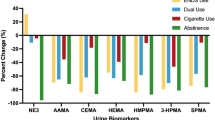Summary
Nicotine and cotinine levels in plasma (pnic, pcot) and urine (unic, ucot) sampled at a steady state were studied in 83 smokers and 90 nonsmokers.
Although there was considerable interindividual variability in measured levels for any given self-reported number of cigarettes smoked per day (CPD), some regularity was discovered among these four levels in relation to CPD.
Average pnic and pcot increased in proportion to CPD up to 15 CPD and more than 50 CPD, but from 20 to 40 CPD, a discrepancy involving more pcot and less pnic was discovered. Average unic rose more rapidly than average ucot up to 15 CPD, but at above 20 CPD, ucot increased more predominantly than unic. In nonsmokers, these four levels were, if detectable at all, extremely low, particularly as concerns cotinine.
The results indicate that the nicotine excretion mechanism may be differential according to the recent uptaken nicotine dosage. In most nonsmokers, the main pathway for nicotine excretion is the nicotine to nicotine route (NNR). The nicotine to cotinine route (NCR) may act as a backup. Light smokers may acquire the ability to convert a greater amount of nicotine to cotinine in proportion to CPD, with both pathways equally available.
Predominant production and excretion of cotinine is suggested for smokers who smoke more than 20 CPD, with the main route replaced by NCR. In extremely heavy smokers who smoke more than 50 CPD, it is suggested that the transaction limits of the nicotine to cotinine conversion system are exceeded and that both pathways are at maximum availability.
As concerns the indicator of ETS exposure for nonsmokers, all four levels are not always completely measurable. It is suggested that pnic is the most sensitive, but all four markers are equally necessary to estimate the low dosage of tobacco smoke uptake.
Access this chapter
Tax calculation will be finalised at checkout
Purchases are for personal use only
Preview
Unable to display preview. Download preview PDF.
Similar content being viewed by others
References
Beckett AH, Triggs EJ (1967) Enzyme induction in man caused by smoking. Nature (Lond) 216:587
Beckett AH, Gorrod JW, Jenner P (1971) The effect of smoking on nicotine metabolism in vivo in man. J Pharm Pharmac 23:Suppl 62S–67S
Biber A, Scherer G, Hoepfner I, Adlkofer F, Heller W-D, Haddow JE, Knight GJ (1986) Determination of nicotine and cotinine in human serum and urine — An interlaboratory study. Toxicol Letters 35:45–52
Benowitz NL, Jacob PHI (1984) Daily intake of nicotine during cigarette smoking. Clin Pharmac Ther 35:499–504
Feyerabend C, Ings RMJ, Russel MAH (1985) Nicotine pharmacokinetics and its application to intake from smoking. Br J Clin Pharmac 19:239–247
Hatchell PC, Collins AC (1977) The influence of genotype and sex on behavioral sensitivity to nicotine in mice. Psychopharmac 71:45–49
Hibberd AR, Gorrod JW (1983) Enzymology of the metabolic pathway from nicotine to cotinine, in vitro. Europ J Drug Metabol Pharmacokinet 8:151–162
Higashi E, Sashikuma F, Itani S, Muranaka H (1985) An examination on an automated determination of urinary hydroxyproline and the relation of tobacco smoking to hydroxypro-line excretion. Rinsho Kensa 29:1838–1842
Higashi E, Sashikuma F, Itani S, Muranaka H (1986) Simultaneous determination of nicotine and cotinine in urine by gas liquid chromatography. Eisei Kagaku 32:276–280
Hoffmann D, Haley NJ, Adams JD, Brunnemann KD (1984) Tobacco sidestream smoke: Uptake by nonsmokers. Preventive Medicine 13:608–617
Jarvis MJ, Russel MAH (1984) Measurement and estimation of smoke dosage to non-smokers from environmental tobacco smoke. Europ J Resp Dis 65 (suppl 133):68–78
Kyerematen GA, Damiano MD, Dvorchik BH, Vesell ES (1982) Smoking induced changes in nicotine disposition: Application of a new HPLC assay for nicotine and its metabolites. Clin Pharmacol Ther 32:769–780
Langone JJ, Van Vunakis H (1975) Quantitation of cotinine in sera of smokers. Research Comm Chem Pathol Pharmacol 10:21–29
Matsukura S, Taminato T, Kitano N, Seino Y, Hamada H, Uchihashi M, Nakajima H, Hirata Y (1984) Effects of environmental tobacco smoke on urinary cotinine excretion in nonsmokers. Evidence for passive smoking. N Engl J Med 311:828–832
Muranaka H, Higashi E, Itani S, Shimizu Y (1988) Evaluation of nicotine, cotinine, thiocyanate, carboxyhemoglobin, and expired carbon monoxide as biological tobacco smoke uptake parameters. Int Arch Occup Environ Health 60:37–41
Nakayama H, Nakashima T, Kuroguchi Y (1985) Cytochrome P-450 dependent nicotine oxidation by liver microsome of guinea pigs. Immunological evidence with antibody against phenobarbital-inducible cytochrome P-450. Biochem Pharmac 34:2281–2286
Peterson LA, Trevor A, Castagnoli N Jr (1987) Stereochemical studies on the cytochrome P-450 catalyzed oxidation of (S)-nicotine to the (S)-nicotine Al′(5′)-iminum species. J Med Chem 30:249–254
Schievelbein H (1982) Nicotine, résorption and fate. Pharmac Ther 18:233–248
Sepkovic DW, Haley NJ, Hoffman D (1986) Elimination from the body of tobacco products by smokers and passive smokers. JAMA 256:863
Wald NJ, Boreham J, Bailey A, Ritchie C, Haddow JE, Knight G (1984) Urinary cotinine as marker of breathing other people’s tobacco smoke. Lancet i:230–231
Editor information
Editors and Affiliations
Rights and permissions
Copyright information
© 1990 Springer-Verlag Berlin Heidelberg
About this chapter
Cite this chapter
Itani, S., Higashi, E., Shimizu, Y. (1990). A Comparison of Plasma and Urinary Nicotine and Cotinine Levels in Smokers and Nonsmokers: Nicotine Excretion Pathways Are Possibly Differential According to the Dosage of Tobacco Smoke Uptake. In: Kasuga, H. (eds) Indoor Air Quality. International Archives of Occupational and Environmental Health Supplement. Springer, Berlin, Heidelberg. https://doi.org/10.1007/978-3-642-83904-7_23
Download citation
DOI: https://doi.org/10.1007/978-3-642-83904-7_23
Publisher Name: Springer, Berlin, Heidelberg
Print ISBN: 978-3-540-51580-7
Online ISBN: 978-3-642-83904-7
eBook Packages: Springer Book Archive




